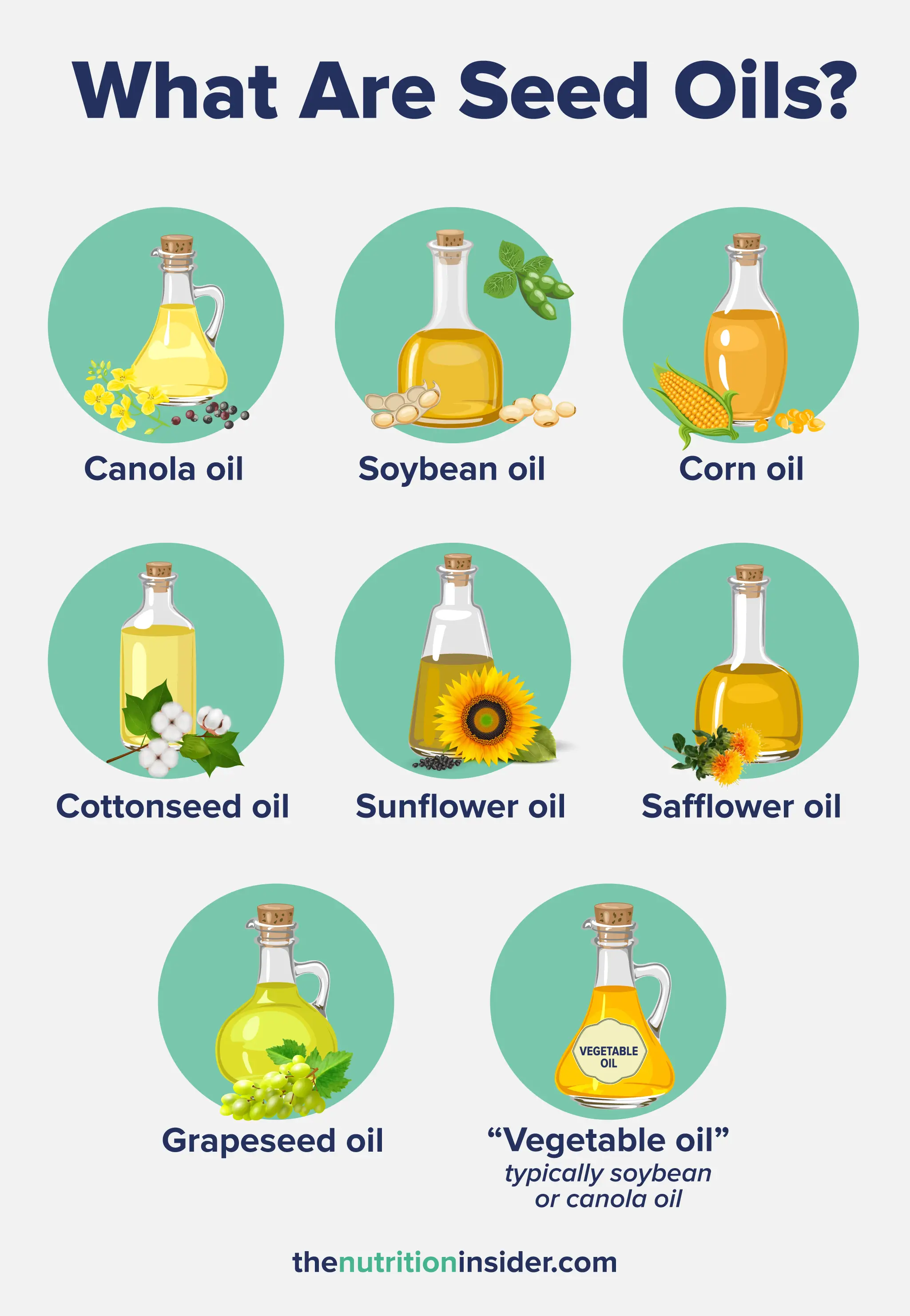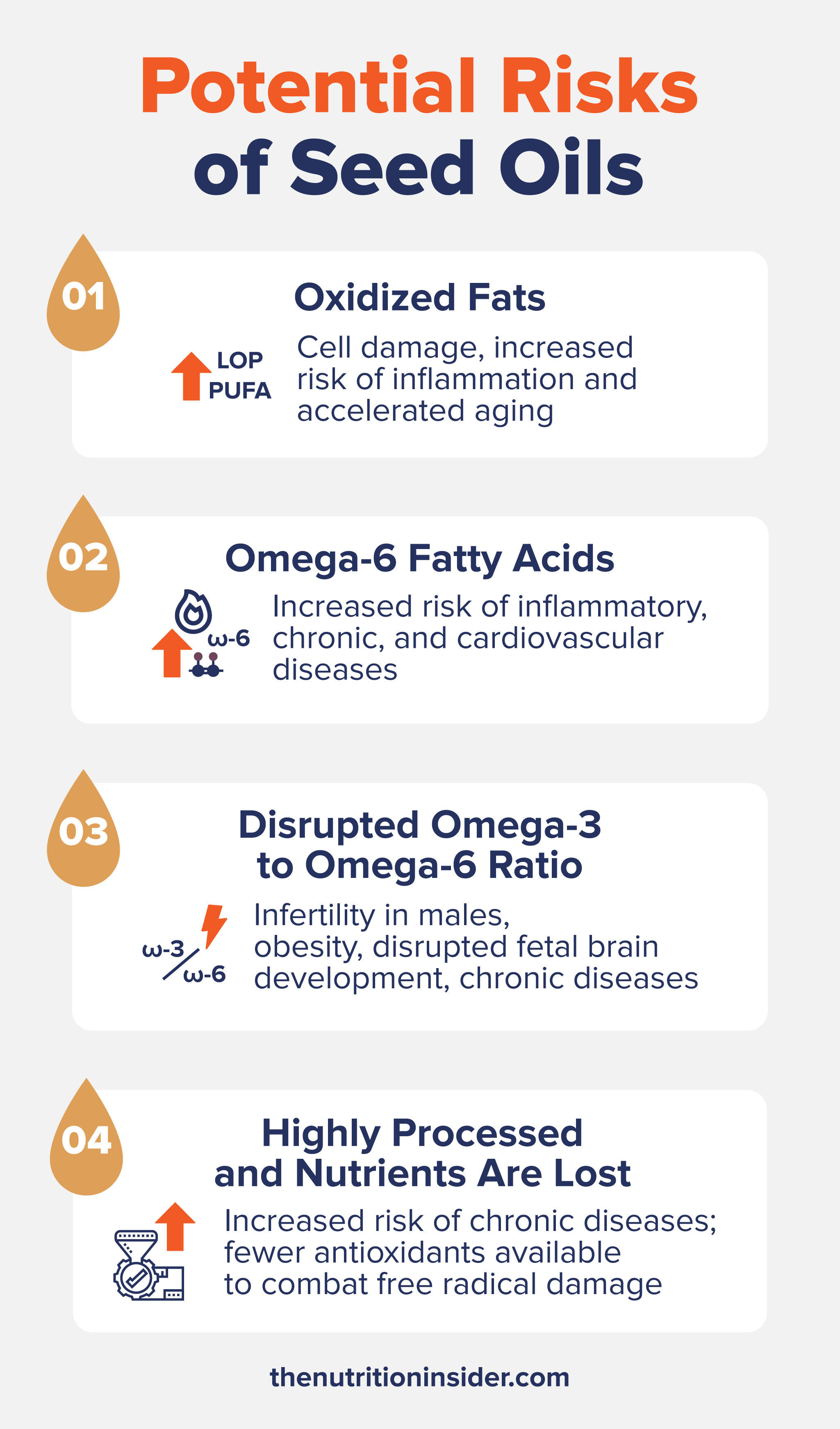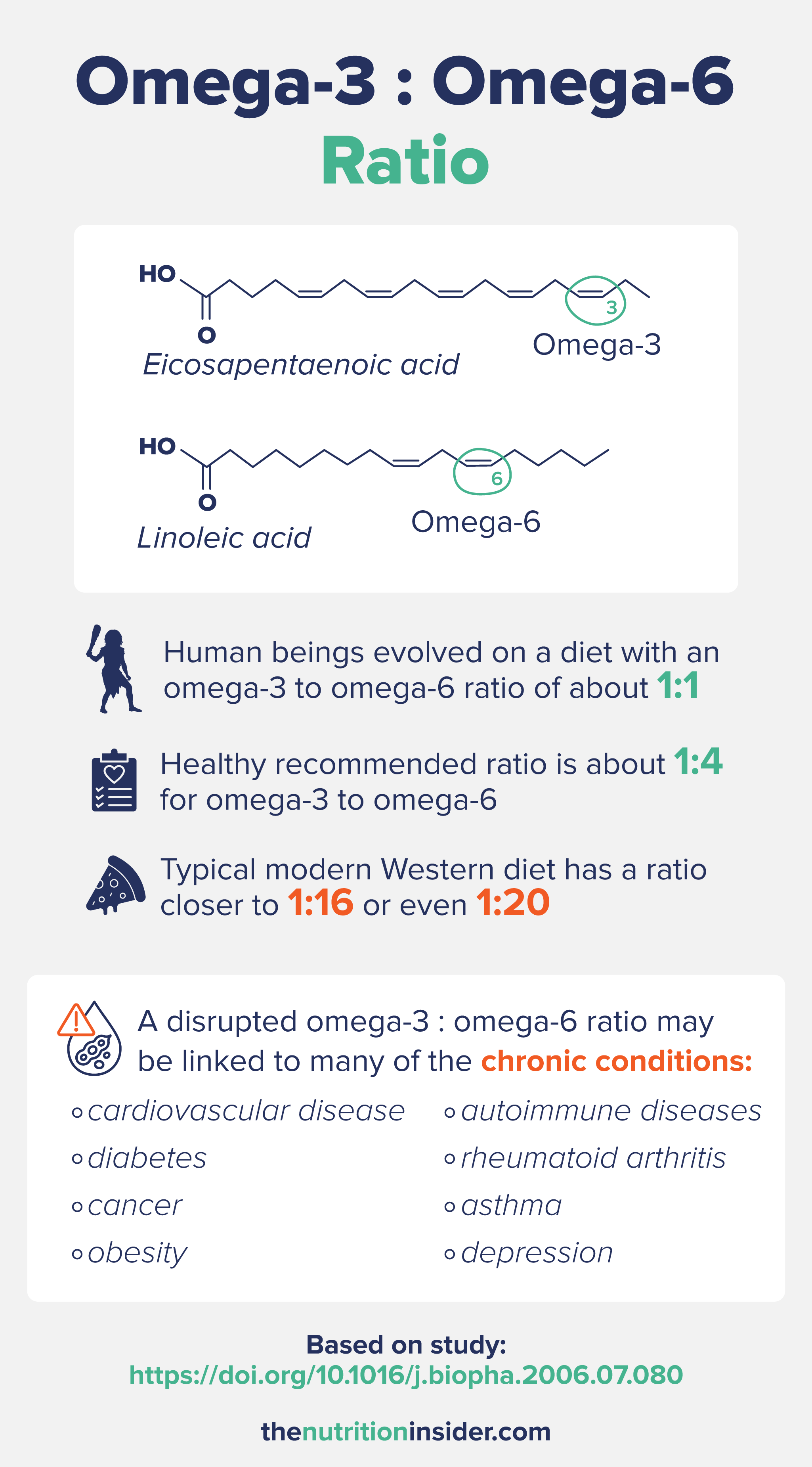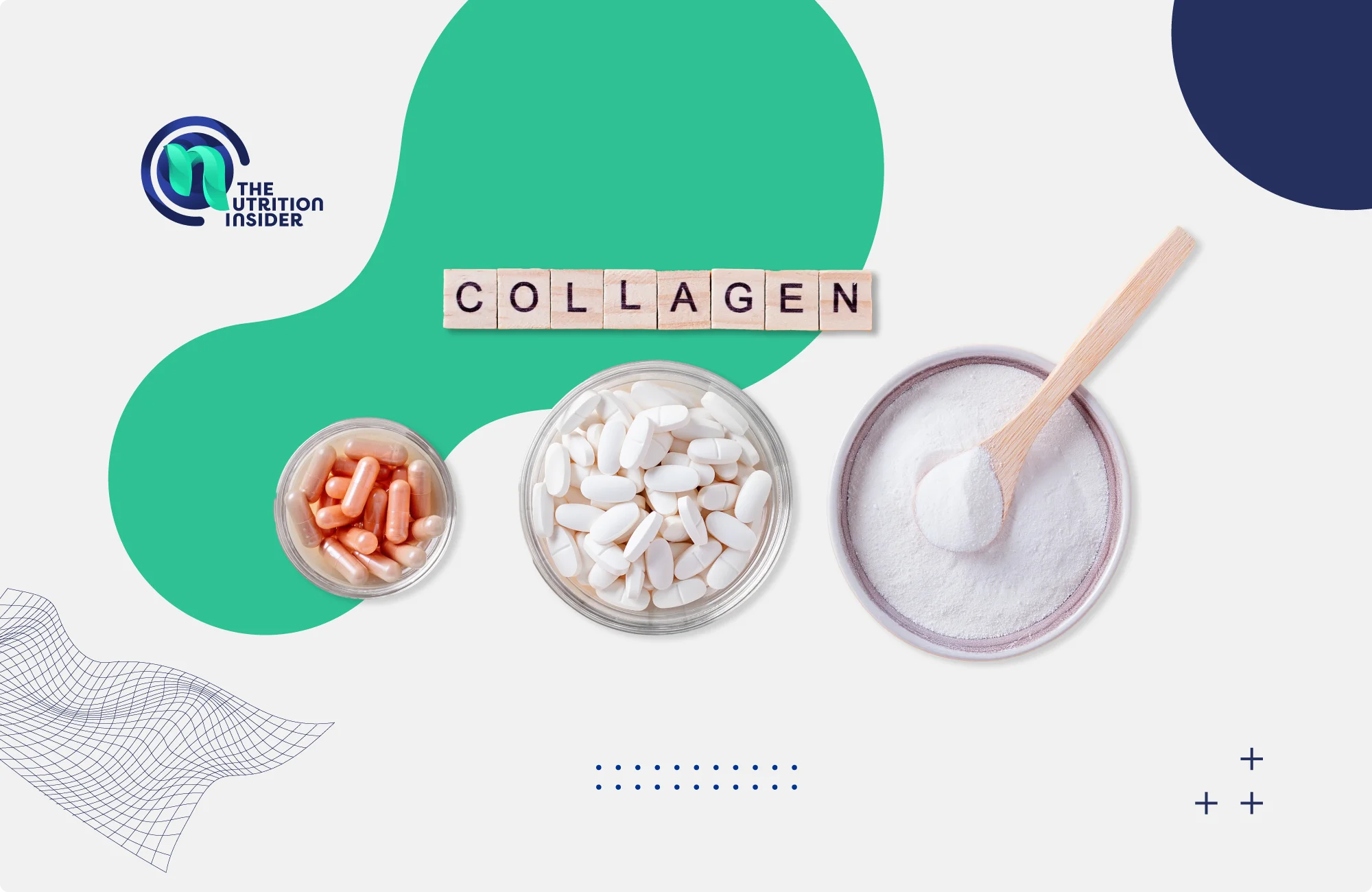This post contains links through which we may earn a small commission should you make a purchase from a brand. This in no way affects our ability to objectively critique the products and brands we review.
Are Seed Oils Bad for You? Insights From a Registered Dietitian
Evidence Based Research To fulfill our commitment to bringing our audience accurate and insightful content, our expert writers and medical reviewers rely on carefully curated research.
Read Our Editorial Policy
If you’re interested in health and wellness and active on social media, you have undoubtedly seen two sides of the seed oil story: the seed oil detractors and the seed oil supporters who say they’re really not that bad (or even healthy).
Both sides sound convincing enough and often have evidence to back it up—so which side is right?
As a Registered Dietitian of 10 years, I can tell you what we learned in school: that canola and other seed oils are heart-healthy options with nutritious fats. In this article, I’ll tell you what I’ve learned since then.
But almost nothing in nutrition research is black and white, so we’ll dive into the details of both sides so that you can make the most informed decision for you and your health.
What Are Seed Oils?
First things first: What are seed oils? Seed oils are an umbrella term that encompasses several oils derived from seeds and plants, including:
- Canola oil
- Soybean oil
- Corn oil
- Cottonseed oil
- Sunflower oil
- Safflower oil
- Grapeseed oil
- “Vegetable oil,” typically soybean or canola oil

Most seed oils are created from seeds, but not all—for example, corn and soybean oil are not from seeds. However, all “seed oils” are higher in omega-6 fats and are typically highly processed.
Soybean oil is the most commonly consumed industrial seed oil, as it’s very cheap and prevalent in many processed and packaged foods and restaurant and fast food meals.
Polyunsaturated Fats: Good or Bad?
To understand the arguments for and against seed oils, we need to understand fat structures.
All oils will have some combination of unsaturated fat and saturated fat. Unsaturated fats are monounsaturated (MUFAs) or polyunsaturated fats (PUFAs), and PUFAs can then be primarily classified into omega-3 or omega-6 fats.
The difference in these fats comes down to their chemical structure. Saturated fats do not have double bonds, so they can “stack” upon each other without leaving gaps. These fats are fully saturated, meaning there is no room for other molecules to bind to them, like harmful free radicals.
Free radicals are unstable molecules that can damage cells, leading to disease and accelerated aging. Due to their chemical stability, predominantly saturated fats such as grass-fed butter, ghee, coconut oil, or tallow are less likely to oxidize and create harmful molecules when heated.
A monounsaturated fat has one double bond, which means there is one open space for another molecule to bind to it. These fats are partially stable because another compound, like a free radical, could still come in and bind to that one open spot. MUFAs are found in high amounts in olive and avocado oil.
Polyunsaturated fats have multiple double bonds, which means they have many open spots for free radicals to bind to. This makes PUFAs very unstable and able to be oxidized more rapidly when exposed to heat or light.1
Both omega-3 and omega-6 fatty acids (both PUFAs) are prone to oxidation if exposed to excessive heat or light. For example, oxidation can occur if you leave fish oil pills in a warm and sunny place or use high-heat cooking with omega-3-rich oils like flaxseed oil. Overall, PUFAs can be very healthy fats as long as they are not oxidized. For example, the omega-3 PUFAs in salmon, walnuts, and flaxseeds are healthy, and the omega-6s found in whole nuts and seeds are also beneficial.
Problems With Seed Oils
There are many potential issues with refined vegetable oils or seed oils that make them less healthy. These include their propensity to oxidize and create harmful molecules that alter cellular health, their high omega-6 content that promotes inflammatory pathways, and the immense amount of processing and refining that depletes nutrients.

Oxidized Fats
Polyunsaturated fats in seed oils like canola or soybean oil have undergone extensive processing like mechanical pressing, bathing in a hexane solution, degumming, bleaching, and deodorizing. While some seed oil processing can be cold-pressed, the majority of these steps introduce heat or light, meaning they may already be oxidized before you even cook with them.
Oils that are repeatedly heated, such as oils used for deep frying in restaurants, are particularly susceptible to oxidation, including the production of lipid oxidation products (LOPs).2
LOPs include epoxy-fatty acids and aldehydes, which are cytotoxic—cell-killing—and can damage DNA, contributing to chronic diseases (including heart disease) and aging.3 These harmful compounds develop when fats are exposed to high temperatures (350F or above) or stored at ambient temperatures for prolonged durations.
This means that even if you aren’t eating deep-fried Twinkies or onion rings, industrial seed or vegetable oils on the grocery store shelf—or in your pantry—can still have lipid oxidation products even before cooking. It’s not disputed that fried foods are unhealthy, but this research shows that seed oils are oxidized before being heated, which is important.
As summarized in an article published in Foods, “It is known that oils or fats rich in unsaturated fatty acids are more prone to suffer oxidation than those with high levels of saturated fatty acids. Lipid oxidation can take place when high temperatures are applied, but also at room temperature, giving rise to a broad variety of compounds, including volatile compounds.”4
In addition, as mentioned above, PUFAs are prone to oxidation because of their double-bond structure, which increases free radicals and reactive oxygen species (ROS) when heated.
Linoleic Acid and Inflammation
Industrial seed oils like soybean, corn, and canola oil are very high in omega-6 fatty acids, especially an omega-6 called linoleic acid.
While omega-6 fats aren’t inherently bad—in fact, they’re essential fatty acids—they can be pro-inflammatory, especially if consumed in excess.
Linoleic acid (LA) itself is not considered pro-inflammatory, but the compounds that come afterward are. Linoleic acid is converted into arachidonic acid (AA), which promotes the synthesis of pro-inflammatory eicosanoids like prostaglandins.5
Eicosanoids are certainly not all bad—without them, we would never heal from injuries ranging from paper cuts to severe burns—but, in excess, our bodies can shift to a pro-inflammatory state.
Not only that, but AA competes with the omega-3 fat eicosapentaenoic acid (EPA), an anti-inflammatory molecule.
However, research is mixed on whether or not eating more omega-6s actually contributes to inflammation-related conditions.
For example, a systematic review and meta-analysis of 30 randomized controlled trials found no significant association between linoleic acid consumption and inflammatory markers. However, smaller group analyses found that people with a much higher linoleic acid intake had increased blood CRP (C-reactive protein) levels, a marker of inflammation.6
Another meta-analysis showed that omega-6 consumption had a null effect on cardiovascular disease, meaning there was no evidence showing that either higher or lower omega-6 intake impacted cardiovascular disease risk.7
So, what gives? Is linoleic acid pro-inflammatory or not?
Researchers published in Advances in Nutrition says, “So an important question is why did the evidence from human clinical trials fail to support the theory that dietary linoleic acid promotes inflammation? One reason might be that the ‘LA-proinflammatory paradigm’ relies on an overly simplified model of LA metabolism.”5
For example, the studies don’t take into account oxidized PUFAs.
Oxidized linoleic acid metabolites called OXLAMs are found to be elevated in several chronic diseases, including fatty liver disease, atherosclerosis, and Alzheimer’s disease—and we know that linoleic acid can oxidize easily.8
Because humans cannot synthesize linoleic acid in the body, it’s known that the linoleic acid we eat—predominantly from seed oils—is the sole contributor to OXLAMs. Research has found that a low-linoleic acid diet significantly reduces the prevalence of OXLAMs.8
Overall, research looking at linoleic acid metabolites—not just linoleic acid, which is not an unhealthy molecule—would be better able to distinguish between inflammation and inflammatory chronic diseases.
It may also come down to genetic differences, as studies have shown that dietary AA and LA increase the risk of cardiovascular disease in those with specific genetic variants, while intake of the omega-3s EPA and DHA decreases the risk.9
Disrupted Omega-3 to Omega-6 Ratio
Omega-6 fatty acids are essential fats that we need to eat, but they tend to be overconsumed in our modern diets.10

Because of these high levels of linoleic acid found in seed oils, most people eating a standard American diet will have much more omega-6 in their body than omega-3.
Our ancestors likely had an omega-3 to omega-6 ratio of about 1:1, but it’s estimated that the typical modern Western diet has a ratio closer to 1:16 or even 1:20. A healthy recommended ratio is about 1:4 for omega-3 to omega-6.9
As mentioned, more omega-6s means more arachidonic acid, which is associated with pro-inflammatory pathways.
But it’s not just the high omega-6s that are the problem; it’s also the lower omega-3s.
Omega-3 and omega-6 fats require certain enzymes to be utilized effectively, and they both compete directly for these enzymes. This means that even if we consume omega-3s, having too many omega-6s in the body can lead to the omega-3s we consume being unable to be used as efficiently.11
A disrupted omega-6 to omega-3 ratio is linked to infertility in males, obesity, disrupted fetal brain development, and heart disease.12-15
As reported by researchers in Biomedicine & Pharmacotherapy, “A high omega-6/omega-3 ratio, as is found in today’s Western diets, promotes the pathogenesis of many diseases, including cardiovascular disease, cancer, osteoporosis, and inflammatory and autoimmune diseases.”9
Highly Processed and Nutrients Are Lost
Lastly, industrial seed oils are considered ultra-processed foods, which are known to be unhealthy and recent additions to the modern diet.
While all cooking oils are processed to some degree, seed oils are much more so than cold-pressed olive oil, for example, which uses a mechanical press with no heat to press the oil out.
As you can imagine, squeezing out the oil from non-oily plants like corn or cottonseed would be much more challenging than olives or avocados, meaning the processing steps are much more intensive.
Industrial oil manufacturers may also add synthetic preservatives like TBHQ, BHA, and BHT to extend shelf life and prevent oxidation, which all have issues of their own.
Also, the refining process strips oils like canola oil of any beneficial compounds they have, like vitamin E and polyphenols, meaning they’re less nutritious than unrefined oils and have fewer antioxidants available to combat free radical damage.16
One study looked at the nutrient content of canola oil during different stages of the refining process. They found that tocopherols (vitamin E), sterols, β-carotene and phenols were all significantly reduced during all phases of oil processing, including neutralization, degumming, deodorization, and bleaching.16
Other research analyzed how different types of canola oil—hexane-dissolved canola seeds, cold-pressed canola oil, and eight commercial canola oil brands—were affected by ultraviolet light, which would induce oxidation. They found that all commercial brands had depleted vitamin E, beta-carotene, and chlorophyll, while cold-pressed canola oil retained much of its nutrients.17
Therefore, if you choose canola oil, ensure it is cold-pressed to maximize its nutritional and antioxidant qualities and in a dark or opaque bottle to minimize oxidation from UV light.
Are There Advantages to Using Seed Oils?
Despite all those potential negatives, there are a few upsides of seed oils to mention.
Several seed oils have a high smoke point, including canola oil (400F), soybean oil (450F), cottonseed oil (420F), and corn oil (450F). However, as you’ve hopefully gleaned from this article, we don’t want to get these seed oils anywhere near those temperatures, as they deteriorate rapidly and create harmful compounds.
Seed oils are also typically much less expensive than olive, avocado, or coconut oil and are more widely accessible in grocery stores nationwide.
Lastly, omega-6-rich seed oils have been shown to lower LDL (“unhealthy”) cholesterol levels. However, lower LDL does not always translate to better heart health.18
As researchers published in BMJ describe, “Available evidence from randomized controlled trials shows that replacement of saturated fat in the diet with linoleic acid effectively lowers serum cholesterol but does not support the hypothesis that this translates to a lower risk of death from coronary heart disease or all causes.”18
The Bottom Line: Are Seed Oils Unhealthy?
Seed oils are high in polyunsaturated fats, which can help to lower unhealthy cholesterol levels. However, their elevated omega-6 levels may contribute to inflammatory pathways in the body and can disrupt the omega-6-to-omega-3 ratio.
They are also commonly found in less-healthy foods, like deep-fried foods, fast food, frozen meals, packaged snacks, and desserts, which don’t need to be demonized but also are not great to include in your regular diet.
If eliminating or reducing seed oils in your diet is challenging, increasing your omega-3 intake can minimize some of the potential inflammatory impacts. Omega-3 fatty acids are found in fatty fish (canned tuna and salmon are great options), sardines, anchovies, walnuts, flaxseed, and chia seeds.
If you have the means to use alternatives to seed oils when cooking at home, I’d recommend doing so. Olive oil, avocado oil, and coconut oil are being more widely used, meaning their prices are becoming more affordable, and they are found more widely in grocery stores nationwide. Grass-fed or pasture-raised animal fats (like tallow, butter, ghee, and chicken schmaltz) are also a great option, as they are mainly saturated fat, but they can be more expensive and harder to find.
Let’s be real, though—we’ll all eat French fries at some point, and most restaurants use seed or vegetable oils when cooking. To minimize your consumption, replace your canola or soybean oil at home with avocado, olive, or coconut oil, and check the ingredient list of packaged foods. Many brands, like Primal Kitchen and Chosen Foods, are now using avocado oil in place of where soybean or canola oil used to be.
We don’t need to eliminate seed oils completely (in fact, it’d probably be impossible to unless you eat 100% of your meals at home), but reducing your intake of these omega-6-loaded oils—and increasing your omega-3 consumption—could potentially go a long way to improve your health.
Although the research on seed oils is still pretty new and sometimes inconclusive, the potential harm is high, so if you have the means to switch them out, why not? Reducing seed oils also means reducing many less-than-healthy packaged and processed foods, and so many other healthful alternatives are becoming more and more affordable and available.
Seed Oil FAQs
What is a good substitute for seed oils?
For cooking, good alternatives to seed oils are extra-virgin olive oil (low to moderate heat), avocado oil, coconut oil, and grass-fed or pasture-raised animal fats like butter, ghee, and tallow. For salad dressings or other non-heat cooking, you could use oils like walnut, macadamia, and sesame oil.
What happens when you stop eating seed oils?
This answer will be different for everybody and will depend on how many seed oils you are consuming and your overall health status. If you stop eating seed oils, you will also reduce your intake of fast food, most snack foods and packaged foods, restaurant meals, and fried food, which will probably produce the largest impact on your health. Anecdotally, you may see reductions in inflammation (like pain or swelling) or inflammatory-related conditions, like arthritis, certain autoimmune diseases, and skin conditions like acne and psoriasis. That said, there are no scientific studies on these benefits.
What foods are high in seed oils?
Fast food, fried foods, snack foods, crackers, mayonnaise, salad dressings, chips, baked goods, packaged desserts, oat milk (sorry!), coffee creamers, some protein shakes, and just about all packaged foods contain seed oils unless the company has made a concerted effort to replace them with avocado oil, coconut oil, or olive oil. If you want to reduce seed oil intake, you need to read ingredient lists judiciously (and accept that restaurant meals will use seed oils unless specifically asked not to).
- Liput, K. P., Lepczyński, A., Ogłuszka, M., Nawrocka, A., Poławska, E., Grzesiak, A., Ślaska, B., Pareek, C. S., Czarnik, U., & Pierzchała, M. (2021). Effects of Dietary n-3 and n-6 Polyunsaturated Fatty Acids in Inflammation and Cancerogenesis. International journal of molecular sciences, 22(13), 6965. https://doi.org/10.3390/ijms22136965
- Perumalla Venkata, R., & Subramanyam, R. (2016). Evaluation of the deleterious health effects of consumption of repeatedly heated vegetable oil. Toxicology reports, 3, 636–643. https://doi.org/10.1016/j.toxrep.2016.08.003
- Grootveld, M., Percival, B. C., Leenders, J., & Wilson, P. B. (2020). Potential Adverse Public Health Effects Afforded by the Ingestion of Dietary Lipid Oxidation Product Toxins: Significance of Fried Food Sources. Nutrients, 12(4), 974. https://doi.org/10.3390/nu12040974
- Ansorena, D., Ramírez, R., Lopez de Cerain, A., Azqueta, A., & Astiasaran, I. (2023). Oxidative Stability and Genotoxic Activity of Vegetable Oils Subjected to Accelerated Oxidation and Cooking Conditions. Foods (Basel, Switzerland), 12(11), 2186. https://doi.org/10.3390/foods12112186
- Fritsche K. L. (2015). The science of fatty acids and inflammation. Advances in nutrition (Bethesda, Md.), 6(3), 293S–301S. https://doi.org/10.3945/an.114.006940
- Su, H., Liu, R., Chang, M., Huang, J., & Wang, X. (2017). Dietary linoleic acid intake and blood inflammatory markers: a systematic review and meta-analysis of randomized controlled trials. Food & function, 8(9), 3091–3103. https://doi.org/10.1039/c7fo00433h
- Al-Khudairy, L., Hartley, L., Clar, C., Flowers, N., Hooper, L., & Rees, K. (2015). Omega 6 fatty acids for the primary prevention of cardiovascular disease. The Cochrane database of systematic reviews, (11), CD011094. https://doi.org/10.1002/14651858.CD011094.pub2
- Ramsden, C. E., Ringel, A., Feldstein, A. E., Taha, A. Y., MacIntosh, B. A., Hibbeln, J. R., Majchrzak-Hong, S. F., Faurot, K. R., Rapoport, S. I., Cheon, Y., Chung, Y. M., Berk, M., & Mann, J. D. (2012). Lowering dietary linoleic acid reduces bioactive oxidized linoleic acid metabolites in humans. Prostaglandins, leukotrienes, and essential fatty acids, 87(4-5), 135–141. https://doi.org/10.1016/j.plefa.2012.08.004
- Simopoulos A. P. (2006). Evolutionary aspects of diet, the omega-6/omega-3 ratio and genetic variation: nutritional implications for chronic diseases. Biomedicine & pharmacotherapy = Biomedecine & pharmacotherapie, 60(9), 502–507. https://doi.org/10.1016/j.biopha.2006.07.080
- Simopoulos A. P. (2002). The importance of the ratio of omega-6/omega-3 essential fatty acids. Biomedicine & pharmacotherapy = Biomedecine & pharmacotherapie, 56(8), 365–379. https://doi.org/10.1016/s0753-3322(02)00253-6
- Lands B. (2014). Dietary omega-3 and omega-6 fatty acids compete in producing tissue compositions and tissue responses. Military medicine, 179(11 Suppl), 76–81. https://doi.org/10.7205/MILMED-D-14-00149
- Safarinejad, M. R., Hosseini, S. Y., Dadkhah, F., & Asgari, M. A. (2010). Relationship of omega-3 and omega-6 fatty acids with semen characteristics, and anti-oxidant status of seminal plasma: a comparison between fertile and infertile men. Clinical nutrition (Edinburgh, Scotland), 29(1), 100–105. https://doi.org/10.1016/j.clnu.2009.07.008
- Simopoulos A. P. (2016). An Increase in the Omega-6/Omega-3 Fatty Acid Ratio Increases the Risk for Obesity. Nutrients, 8(3), 128. https://doi.org/10.3390/nu8030128
- Cinquina, V., Keimpema, E., Pollak, D. D., & Harkany, T. (2023). Adverse effects of gestational ω-3 and ω-6 polyunsaturated fatty acid imbalance on the programming of fetal brain development. Journal of neuroendocrinology, 35(9), e13320. https://doi.org/10.1111/jne.13320
- DiNicolantonio, J. J., & O’Keefe, J. H. (2018). Omega-6 vegetable oils as a driver of coronary heart disease: the oxidized linoleic acid hypothesis. Open heart, 5(2), e000898. https://doi.org/10.1136/openhrt-2018-000898
- Wu, Y., Zhou, R., Wang, Z., Wang, B., Yang, Y., Ju, X., & He, R. (2019). The effect of refining process on the physicochemical properties and micronutrients of rapeseed oils. PloS one, 14(3), e0212879. https://doi.org/10.1371/journal.pone.0212879
- Saleem, M., & Ahmad, N. (2018). Characterization of canola oil extracted by different methods using fluorescence spectroscopy. PloS one, 13(12), e0208640. https://doi.org/10.1371/journal.pone.0208640
- Ramsden, C. E., Zamora, D., Majchrzak-Hong, S., Faurot, K. R., Broste, S. K., Frantz, R. P., Davis, J. M., Ringel, A., Suchindran, C. M., & Hibbeln, J. R. (2016). Re-evaluation of the traditional diet-heart hypothesis: analysis of recovered data from Minnesota Coronary Experiment (1968-73). BMJ (Clinical research ed.), 353, i1246. https://doi.org/10.1136/bmj.i1246








